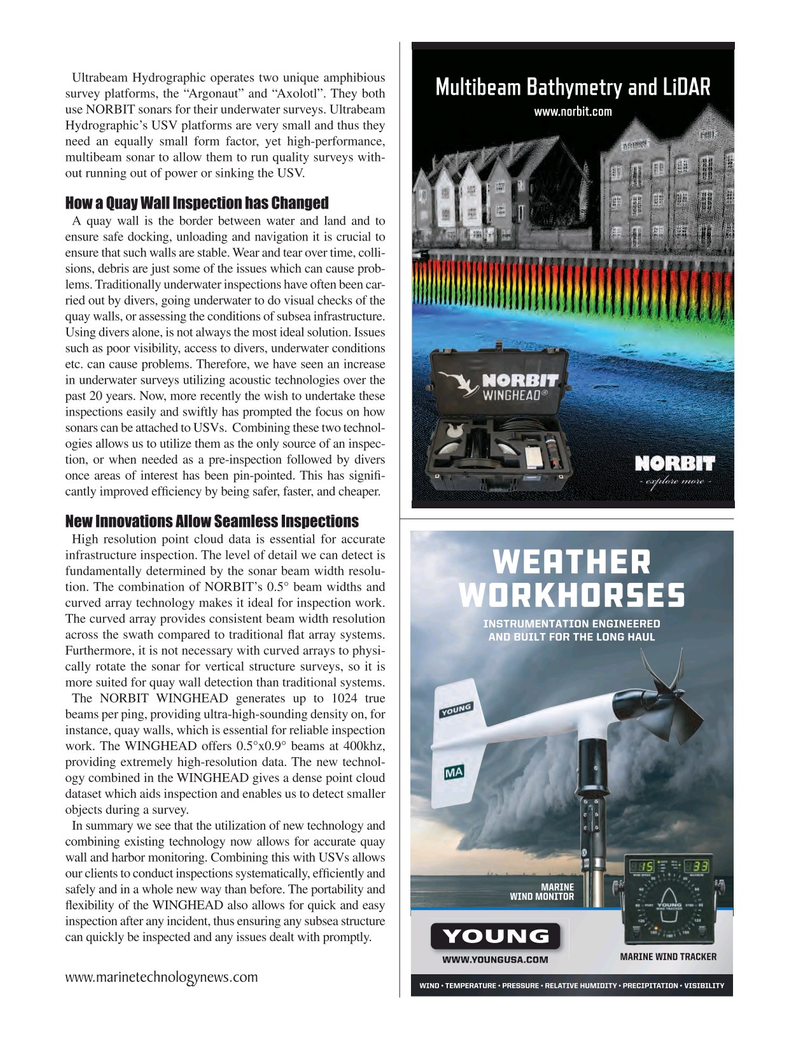
Page 49: of Marine Technology Magazine (November 2022)
Read this page in Pdf, Flash or Html5 edition of November 2022 Marine Technology Magazine
Ultrabeam Hydrographic operates two unique amphibious
Multibeam Bathymetry and LiDAR survey platforms, the “Argonaut” and “Axolotl”. They both use NORBIT sonars for their underwater surveys. Ultrabeam www.norbit.com
Hydrographic’s USV platforms are very small and thus they need an equally small form factor, yet high-performance, multibeam sonar to allow them to run quality surveys with- out running out of power or sinking the USV.
How a Quay Wall Inspection has Changed
A quay wall is the border between water and land and to ensure safe docking, unloading and navigation it is crucial to ensure that such walls are stable. Wear and tear over time, colli- sions, debris are just some of the issues which can cause prob- lems. Traditionally underwater inspections have often been car- ried out by divers, going underwater to do visual checks of the quay walls, or assessing the conditions of subsea infrastructure.
Using divers alone, is not always the most ideal solution. Issues such as poor visibility, access to divers, underwater conditions etc. can cause problems. Therefore, we have seen an increase in underwater surveys utilizing acoustic technologies over the past 20 years. Now, more recently the wish to undertake these inspections easily and swiftly has prompted the focus on how sonars can be attached to USVs. Combining these two technol- ogies allows us to utilize them as the only source of an inspec- tion, or when needed as a pre-inspection followed by divers once areas of interest has been pin-pointed. This has signi? - cantly improved ef? ciency by being safer, faster, and cheaper.
New Innovations Allow Seamless Inspections
High resolution point cloud data is essential for accurate infrastructure inspection. The level of detail we can detect is fundamentally determined by the sonar beam width resolu- tion. The combination of NORBIT’s 0.5° beam widths and curved array technology makes it ideal for inspection work.
The curved array provides consistent beam width resolution across the swath compared to traditional ? at array systems.
Furthermore, it is not necessary with curved arrays to physi- cally rotate the sonar for vertical structure surveys, so it is more suited for quay wall detection than traditional systems.
The NORBIT WINGHEAD generates up to 1024 true beams per ping, providing ultra-high-sounding density on, for instance, quay walls, which is essential for reliable inspection work. The WINGHEAD offers 0.5°x0.9° beams at 400khz, providing extremely high-resolution data. The new technol- ogy combined in the WINGHEAD gives a dense point cloud dataset which aids inspection and enables us to detect smaller objects during a survey.
In summary we see that the utilization of new technology and combining existing technology now allows for accurate quay wall and harbor monitoring. Combining this with USVs allows our clients to conduct inspections systematically, ef? ciently and safely and in a whole new way than before. The portability and ? exibility of the WINGHEAD also allows for quick and easy inspection after any incident, thus ensuring any subsea structure can quickly be inspected and any issues dealt with promptly. www.marinetechnologynews.com
MTR #8 (34-49).indd 49 11/28/2022 6:31:52 PM

 48
48

 50
50
